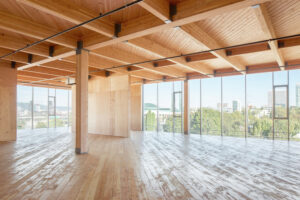Research Purpose:
Explore how mass timber buildings can be optimized for material efficiency, and support a regionally-specific LCA case study of an office building in the Pacific Northwest.
Report published: February, 2018
About
Transitioning construction of low to mid-rise commercial and non-residential structures to cross-laminated timber (CLT)/heavy timber construction could have a positive impact on the environment. It could also develop a new market for the smaller diameter and lower quality logs derived from forest thinning and forest health operations, thereby providing an incentive to undertake forest management activities designed to improve forest health and resiliency. Finally, the development of a cross-laminated timber industry would provide substantial economic benefits and employment opportunities for rural timber-dependent communities.
The UW Architecture team defined a reference commercial office building using heavy timber/CLT to substitute for conventional construction. The School of Forest Resources Team developed a regionally-specific life cycle assessment models to evaluate the environmental impact of potential CLT production in the Olympic Peninsula.
Results
Journal Publications
- Pierobon, F., Huang, M., Simonen, K., Ganguly, I. Environmental benefits of using hybrid CLT structure in midrise non-residential construction: An LCA based comparative case study in the U.S. Pacific Northwest. Journal of Building Engineering. https://doi.org/10.1016/j.jobe.2019.100862
Research team
- I. Ganguly (PI)
- K. Simonen (co-PI)
- F. Pierobon
- M. Huang
- K. Strobel
Acknowledgments
This research was funded by the USDA under a McIntire-Stennis Grant and includes contributions from Architecture students: Mariam Hovhannisyan, Ezekiel Jones, Weston Norwood, Barbara X. Rodriguez, and Kristen Strobel.
